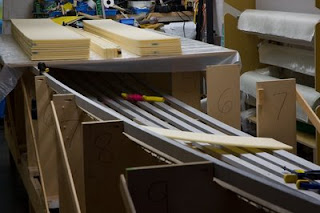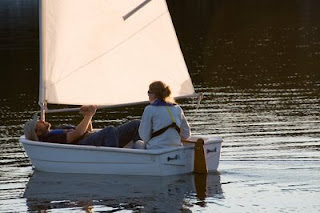An idea came to me after making the first float half, and it seemed to save considerable time and effort with the next three.
Start by planning what size planks to use, then follow this plan for all four halves. I used two sizes so that I could alternate as necessary -- so as to not have any plank edges over the forms (it's difficult to screw too close to the form from underneath, so this eliminates any concern about holding the edge down). I chose 12-inch and 9-inch planks, because planks larger than 12 inches were difficult to curve and my sheets of foam were easily divided with these measurements without wastage.
So, starting with three 12-inch planks between forms 6 and 7, flank with the 9-inch and proceed in both directions, choosing 12-inch when able, 9-inch if necessary (look more than one plank ahead).
Mark the edge on the battens, then pre-drill from the top. I tended to use one screw near each edge and one in middle. Although I pre-drilled all battens, I skipped putting screws in some if there wasn't much curve to hold. (I would suggest experimenting with two screws placed at thirds -- since the battens are either nearly flat or concave in the fore-aft direction, it's possible that two screws closer to the middle would suck the foam down and the edges would hold themselves. I never tried this for reasons below.)
Partially pre-place the screws from below before fitting the foam. This is easier than starting the screws balanced on the driver with the foam and an extra hand above. Then place foam with counter pressure from above, double checking alignment before it's too late.
Here's the real time-saver:
When you remove the float, only back out the screws halfway! When planking the next float, just follow the same pattern of plank widths and most of the work done stooping and kneeling is already done.
I didn't take many pictures. Here are the forms turned around with the battens replaced. I did it with the screws in place, which worked fine. I was a little concerned about 'memory' of the battens so several were replaced. The foam, including keel pieces, are pre-cut and waiting.
I had a glass-cutting session to get ready for the next two halves and the beam mounting flanges for each float.
I was able to finish the third half and join two together. It all went without a hitch. I'll put up a couple details with pictures next time.
I did take a closer picture of the wrinkles that can be left from the plastic using the PMVB technique. I have experimented with several thicknesses, but the issue of wrinkles left from the packaging folds are always present to some degree. Below is one of the worst examples, but you can see that when the PP is removed, the wrinkle comes with it (*almost* all the time). After smoothing/working with the squeegee, some of the fold in the plastic gradually returns, sucking some resin with it. The glass remains against the foam. A couple of wrinkles have remained under the PP (in much reduced size), where the PP was also slightly pulled into the fold, but in all instances so far the glass is flat -- meaning that the epoxy 'wrinkle' can be lightly sanded flat without hurting the glass. Since the final product looks great 99% of the time and the resin ripples happen infrequently (and they're easier to fix than bubbles, of which I've had none), I plan on continuing with this technique.
The most important thing to ensure the success of a proper glass/resin ratio and smooth surface seems to be to put adequate resin on top of the plastic so that you can squeegee without any resistance against it.
The end of July and first part of August was our family vacation. This year we took a three week sailing trip in the San Juan and southern Canadian Gulf Islands. I have always been fortunate to be able to use my father's trimaran, 'TRICE', which he built and launched in 1967. It has been well cared for and updated over the years, making a perfect family cruising platform for over 40 years. Since both my parents were teachers, we spent my childhood summers sailing, and being able to share that with my family has been extra special.
Heading north from La Conner, WA, the 'Gateway to the San Juan Islands.'
Most of the San Juans are dry because of the rain shadow of the Olympic Mountains. Farther north this shadow disappears, making the hikes a little more green.
One of our favorite anchorages in British Columbia, Canada. Stern line ashore on the north side of Portland Island, all of which is a marine park.
Kayaking allows phenomenal sights.
A couple of pointers before setting the girls off solo.
There are several resident pods of Orca whales.
The end to a slow, relaxing vacation. Just what the family needs. Looking forward to splashing F22!










